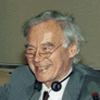
Biografia estratta da http://education.guardian.co.uk/
(1925-2002) The physicist Sir William 'Bill' Mitchell, who has died aged 77, pioneered a hugely powerful method of analysing the intimate structure and properties of solid materials by neutron scattering. He made fundamental discoveries about the characteristics of objects, ranging from diamonds to the semiconductor compounds needed for microcomputers. Neutron scattering is big science. The equipment needed to generate beams of neutrons to probe the centre of atoms costs millions of pounds, and there are only a handful of centres in Europe where the analysis can be done. Their existence owes a large debt to Mitchell's tireless efforts in fostering European research partnerships.
The technique has become so successful that the demand from university and industrial teams for facilities to explore the properties of solids and liquids - from chemistry to gene technology and fundamental physics to engineering - has outstripped supply. Born in Kingsbridge, Devon, Mitchell went, in 1943, to take his physics degree at Sheffield University, which had become an academic hothouse for training specialists in the optics, radio and electronics needed for radar and defence communications. In 1946, he joined the research department of Metropolitan Vickers, which seconded him to Bristol University.
There, his fascination with state physics began in the department of Neville Mott, who later won a Nobel prize for his work on the electronic properties of unusual materials. After completing his PhD, Mitchell returned briefly to Metropolitan Vickers, but left in 1951 for a lectureship in the fledgling research department at Reading University, then under the supervision of RW Ditchburn, a physicist with an international reputation in the field of optics. Mitchell's interest in diamonds was stimulated by Ditchburn, who had stepped into a controversial issue over the degree of sparkle that comes from different diamonds. His research, published in the monumental book Light (1952), showed that no more than 91% of the light falling on a diamond could be reflected, whatever its shape or quality. Mitchell was encouraged by Ditchburn to open new lines of research at Reading, and he soon established a formidable solid state physics group exploring the electronic properties of exotic materials.
By the time he became professor of physics in 1961, he had honed other management and administrative skills that would later serve him in great stead as chairman of the science and engineering research council (SERC). In 1966, he became dean of science, and then deputy vice-chancellor, at Reading, before moving to Oxford in 1978 as Dr Lees professor of experimental philosophy and head of the Clarendon laboratory, where he galvanised interest in his own field, in particle physics, astrophysics and other areas His conviction of the huge potential of neutron scattering as a research tool was confined for a long time to a small band of physicists. As chairman of the SERC's neutron beam research committee from 1966 to 1974, he was perhaps its most fervent flag carrier.
At Reading, Mitchell had developed methods of neutron-scattering analysis of materials using research reactors at the atomic energy research establishments at Harwell and Aldermaston, and devised a scheme for their wider use by other universities. As demand grew, it became clear that a purpose-built centre for neutron-scattering work was needed; the government was not prepared to pay for one, but accepted the idea of sharing the costs. It was Mitchell who led the British team that negotiated a partnership with France and Germany to build the special purpose reactor at the Institut Laue-Langevin in Grenoble, now an international centre of excellence.
His success as a safe pair of hands in swaying committees and smoothing disputes made him a natural candidate for SERC chairman in 1985. Relations between universities and the government were at a low ebb because of a shortage of money for research and postgraduate training, and interference from the Department of Education and Science. Although strapped for cash, Mitchell negotiated changes to get the best value possible in allocating the council's funds for universities, while preserving the independence of academic researchers. He oversaw the controversial introduction of interdisciplinary research centres in universities to concentrate research funding on key areas like materials science and electronics. He also inherited a row about moving the Royal Greenwich Observatory at Herstmonceux, Sussex, to a more appropriate site, and, against howls of protest, agreed its transfer to Cambridge.
As vice-president of the European Science Foundation (1989-92), Mitchell encouraged plans for a series of European research conferences, modelled on the prestigious Gordon conferences in the United States, which had attracted more than 10,000 scientists and evolved a distinctive forum for shar ing ideas at the frontiers of scientific disciplines. Attendance was restricted to 125 people for each conference, and all discussions were off the record.
These exchanges of information were probably about two years ahead of the relevant topic's appearance in the open literature. In 1991, Mitchell served as president of Cern, the European centre for particle physics research, in Geneva. He was a fellow of the Royal Society, and was elected to the Royal Society of South Africa in recognition of his work on diamond physics. He is survived by his second wife, Margaret, and a son from his first marriage. · Edgar William John Mitchell, physicist, teacher, science policy adviser and administrator, born September 25 1925; died October 30 2002